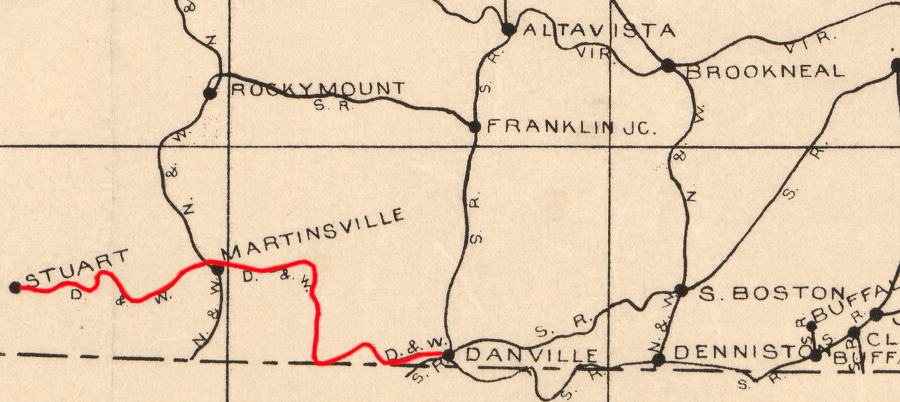
the Danville & Western Railway ran from Danville to Patrick Court House (Stuart)
Source: Library of Congress, Railway mail map of Virginia (Earl P. Hopkins, c.1910)

the Danville & Western Railway ran from Danville to Patrick Court House (Stuart)
Source: Library of Congress, Railway mail map of Virginia (Earl P. Hopkins, c.1910)
The Danville and New River Railroad was a narrow gauge railroad chartered in 1873, then built in 1880-1882.
Construction started at Stokesville, south of Danville, then moved west past Berry Hill and Cascade. One mile of track dipped across the state border into North Carolina on the way to Martinsville, 43 miles to the west of Danville. In 1884, trains began to run to what became the end of the line at Patrick Court House (now Stuart) in Patrick County.1
The Richmond and Danville Railroad initially supported construction of the Danville and New River Railroad. The Pennsylvania Railroad, which controlled the Richmond and Danville Railroad though its Southern Railway Security Company, saw the new line as a way to impede the expansion of the Baltimore and Ohio (B&O) Railroad into North Carolina.
In the 1870's, the Baltimore and Ohio Railroad controlled a competitor of the Richmond and Danville Railroad, the Virginia Midland Railroad. That line ran north from Danville to Lynchburg, then via the old Orange and Alexandria Railroad route to Alexandria, but the Baltimore and Ohio Railroad controlled no track south of Danville. An extension of the Virginia Midland Railroad would increase traffic from the Carolinas moving north to Alexandria, diverting traffic from the Richmond and Danville Railroad and undercutting revenues of the B&O's rival Pennsylvania Railroad.
Construction of the Danville and New River Railroad would steer traffic from the Piedmont to the Richmond and Danville Railroad. That might increase the Pennsylvania Railroad's revenue a little, but more importantly the track to Patrick Court House would limit the economic feasibility of the B&O extending the Virginia Midland Railroad into North Carolina.2
However, the Pennsylvania Railroad sold its interests in the Richmond and Danville Railroad to the Clyde Syndicate in 1880. That ended the interest of one group of deep-pocketed northern investors in funding further construction of the Danville and New River Railroad.
The investors in the Richmond and Danville Railroad remained supportive of the extension. They anticipated that the Danville and New River Railroad would increase local traffic enough to justify the cost of a narrow-gauge railroad, but not a line using the 5' wide gauge of the Richmond and Danville Railroad.
Building new railroad as a narrow gauge line minimized initial construction costs at a time when investment capital was scarce. Construction started by adding a third rail to the track of the Piedmont Railroad, which the Richmond and Danville owned, between Danville and the community south of town called Stokesland.
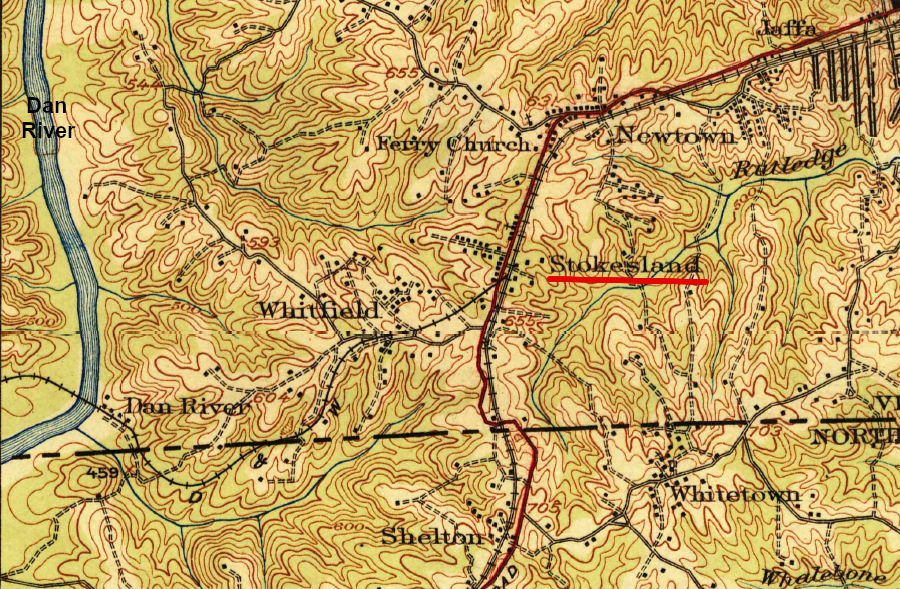
the Danville and New River Railroad built west from Stokesville, crossing into North Carolina for one mile of track
Source: US Geological Survey (USGS), Danville 1:62,500 topographic quadrangle (1925)
The extra third rail also crossed the bridge over the Dan River. If the Richmond and Danville Railroad had been uncooperative, the narrow gauge Danville and New River Railroad would have struggled to find the financial resources to build its own bridge. To reduce costs, it relied upon convict labor for construction.
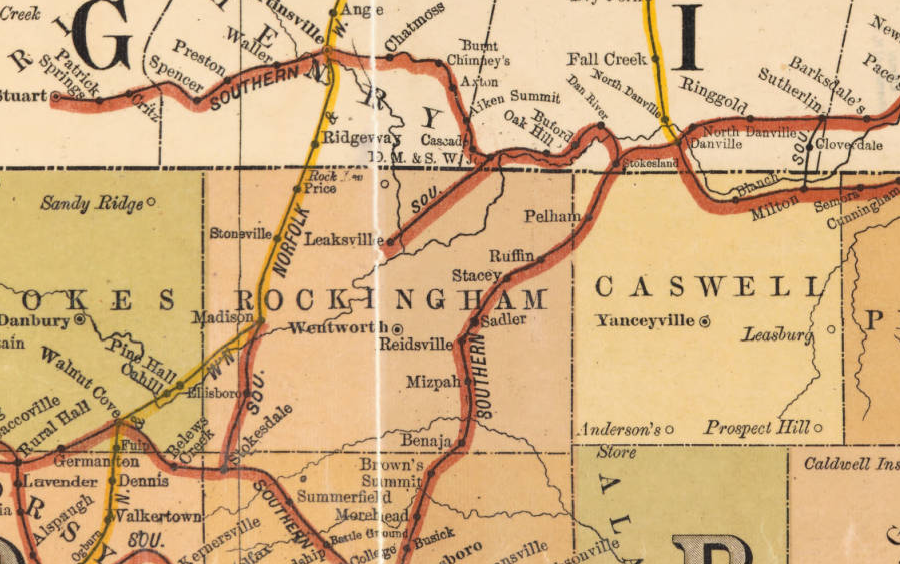
the Danville & Western Railway acquired the Danville, Mocksville & Southwestern Railroad track to Leakesville
Source: University of North Carolina, Railroad map of North Carolina 1900 (by Henry C. Brown, 1900)
The Danville and New River Railroad was never extended after 1884 past Stuart to the New River. There was not enough potential traffic to justify building through the Blue Ridge, where construction costs would be excessively high. Different railroads were constructed in the mountains between Stuart and Bristol, but they were never connected to create an east-west or a north-south through route.
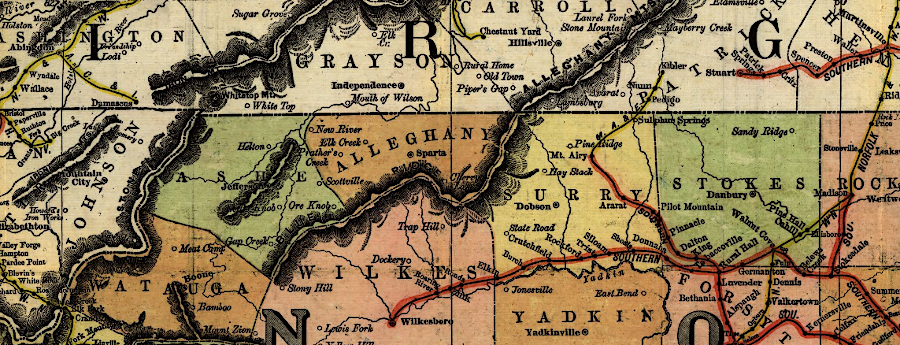
plans to extend the Danville and New River Railroad west from Stuart across the Blue Ridge were never implemented
Source: Library of Congress, Railroad map of North Carolina, 1900 (by H. C. Brown, 1900)
One of the railroads that sought to build into the Blue Ridge was the Mount Airy & Eastern Railway, which was completed between Mount Airy, NC and Kilber. That railroad, chartered in 1899, was a narrow gauge line designed to haul timber. It built track north from Mount Airy to Goins, Virginia in 1900. After going bankrupt in 1901, it was reorganized and track built further north to a lumber mill at Kilber in 1902. Plans to built 10 miles east to Stuart were prepared in 1904, but no construction occurred.
The Mount Airy & Eastern Railway went bankrupt again in 1910, then was sold in 1915 to a company which owned 12,000 acres of hardwood timber land. It stopped operating in 1918, and was liquidated around 1930. The proposed track east to Stuart was never built.3
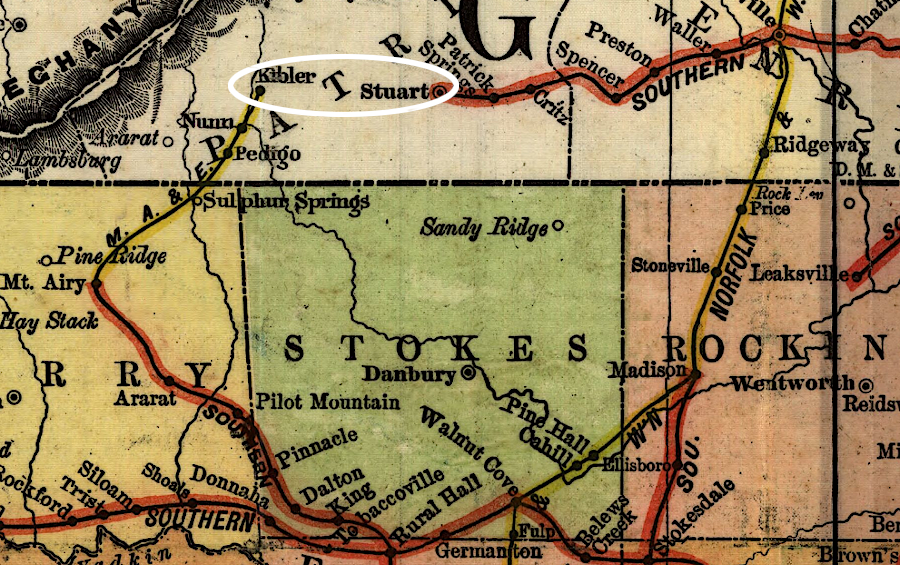
the Mount Airy & Eastern Railway proposed building from the lumber mill at Kibler east 10 miles to Stuart, but went out of business in 1918
Source: Library of Congress, Railroad map of North Carolina, 1900 (by H. C. Brown, 1900)
North of Danville, the Virginia and Tennessee Railroad cut through the mountains via the Roanoke River water gap. South of Danville, the Western North Carolina Railroad built the Swannanoa Tunnel and reached Asheville in 1880, then completed a link to Knoxville by building west down the French Broad River to meet the East Tennessee, Virginia, and Georgia Railroad.
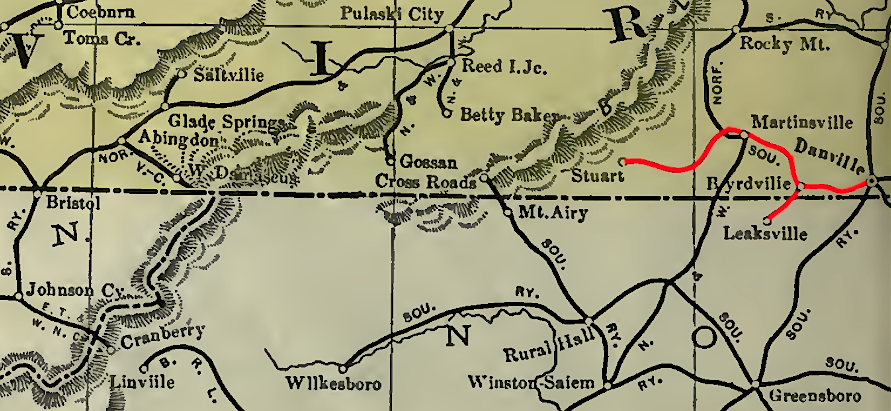
the Danville and New River Railroad and many other railroads in the Piedmont were never extended west across the Blue Ridge
Source: Poors Manual of Railroads 1901, Railroad Map of the United States - Delaware, Maryland, Virginia and West Virginia (after p.128)
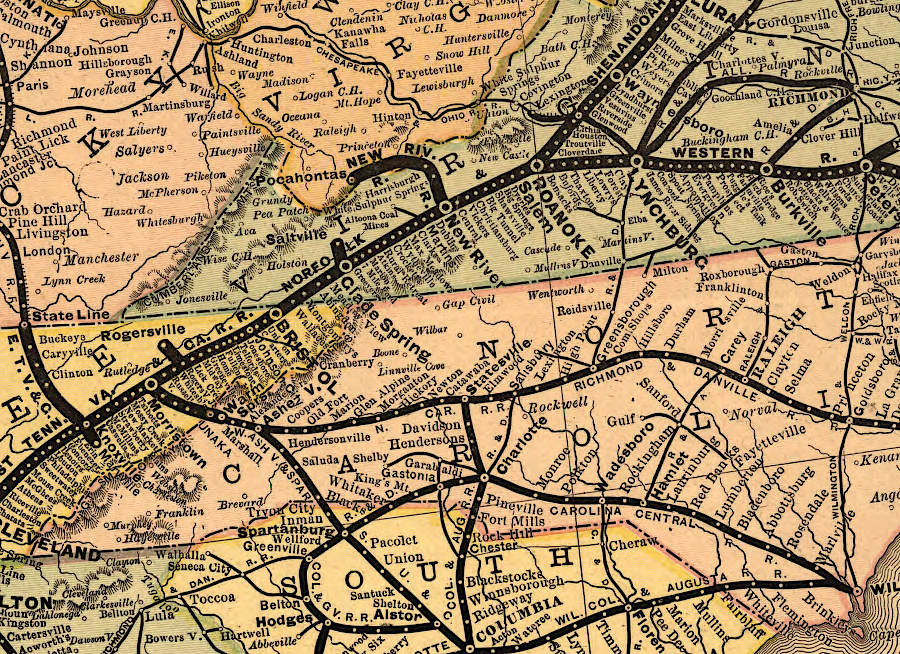
in 1882 railroads crossed the Blue Ridge at Roanoke and Asheville, and not in-between until construction of the Carolina, Clinchfield and Ohio Railway
Source: Library of Congress, The Virginia, Tennessee, and Georgia Air Line; the Shenandoah Valley R.R.; Norfolk & Western R.R.; East Tennessee, Virginia, & Georgia R.R. (its leased lines,) and their connections (1882)
The Danville and New River Railroad did extend south by acquiring the Danville, Mocksville & Southwestern Railroad. That narrow gauge railroad had also started in 1880. It built eight miles of track by 1882 to Leaksville, North Carolina. Leaksville, Spray, and Draper merged to become the municipality of Eden in 1967.
Thanks to waterpower from the Dan and Smith rivers, that part of North Carolina developed into an industrial area with textile mills (including Fieldcrest Mills) that generated railroad traffic. The spot near Cascade in Virginia, where the Danville, Mocksville & Southwestern Railroad track started south, became known as Leaksville Junction. Water tanks, coal bins, and a turntable were installed there.
In 1883, the Danville, Mocksville & Southwestern Railroad was in receivership. The Danville and New River Railroad took over operations, then made it into just a branch line in 1899.
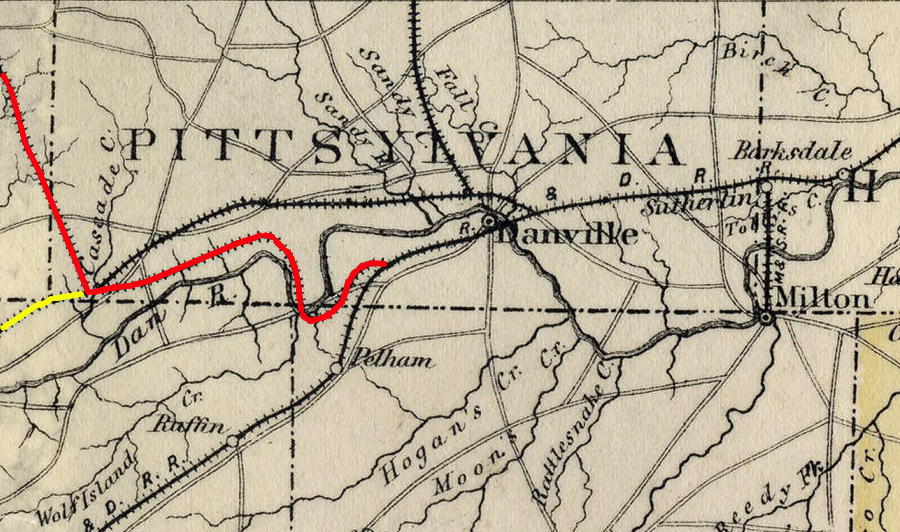
Danville & Western Railway track towards Stuart (red) and the Danville, Mocksville & Southwestern Railroad track towards Leakesville (yellow)
Source: University of North Carolina, Map of North Carolina (by Washington C. Kerr, 1882)
In 1891, the Danville and New River Railroad went through bankruptcy and was renamed the Danville & Western Railway.4
The Richmond and Danville Railroad acquired control, but kept the Danville & Western Railway as a separate company.
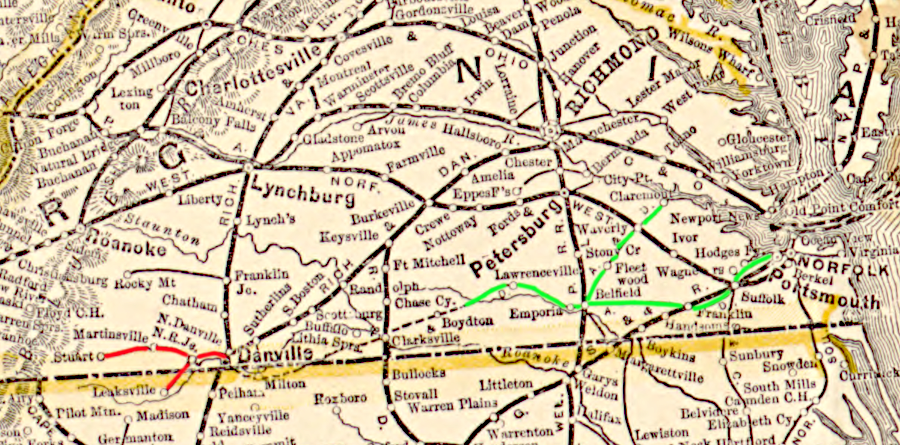
the Danville & Western Railway (red) was completed to Stuart in 1884, before the Atlantic and Danville Railroad (green) started to built west from Emporia in 1887
Source: Library of Congress, Map of the Nashville, Chattanooga and St. Louis Ry.; and connections. (by W. L. Danley, 1889)
That purchase blocked a potential rival, the Atlantic and Danville Railroad, from acquiring the line. It also provided the resources for conversion from wood-burning locomotives to steam engines that used coal. At one point, locomotives hauled two passenger trains and four freight trains daily between Stuart and Danville.5
Once the Atlantic and Danville Railroad completed building its track from Emporia to Danville, there was potential allying with or purchasing the Danville and New River Railroad. Such a combination would create a railroad line stretching east from the Blue Ridge, parallel to the North Carolina border, to wharves on the Chesapeake Bay at Portsmouth.
Allowing the Atlantic and Danville Railroad to extend west of Danville could affect the dominance of the Richmond and Danville Railroad. The Richmond and Danville wanted to carry freight and passengers from Danville to Richmond, not have a competitor transport people and freight to Portsmouth.
Another railroad did enter the territory west of Martinsville, but it was a north-south line.
The Roanoke & Southern Railway was built south from Roanoke to Winston-Salem, North Carolina. It passed west of Martinsville in 1892. The Norfolk and Western quickly took control of the railroad line, which was later called the "Pumpkin Vine." The Danville & Western Railway built a four-mile connection to the Roanoke & Southern at Koehler, allowing the two railroads to interchange traffic.
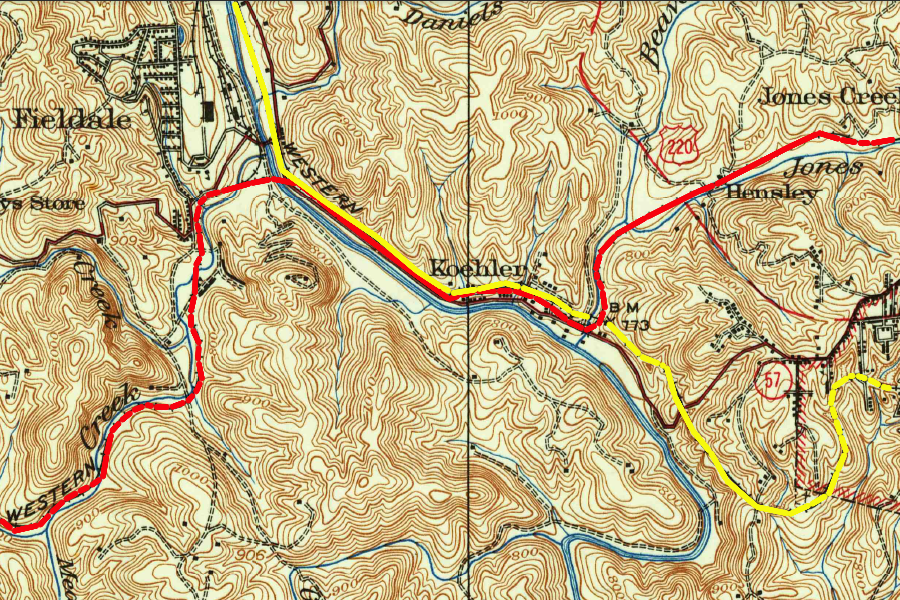
the Danville & Western Railway (red) and the Norfolk and Western "Pumpkin Vine" (yellow) crossed west of Martinsville
Source: US Geological Survey (USGS), Martinsville VA 1:62,500 topographic quadrangle (1927)
The topography of the Blue Ridge made Danville & Western Railway construction further west of Stuart unrealistically expensive. After the Richmond and Danville Railroad gained control of the Virginia Midland and eliminated that threat of competition, there was little economic justification for further expansion of the old Danville, Mocksville & Southwestern Railroad beyond Leakesville.
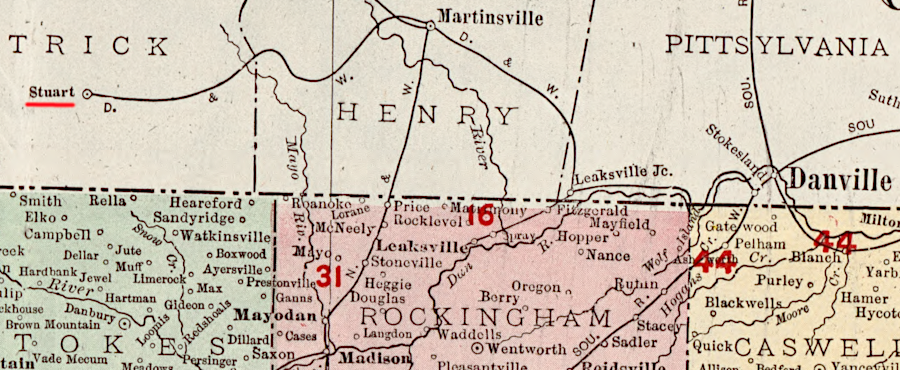
the Danville & Western Railway reached Stuart, west of Martinsville
Source: Library of Congress, North Carolina (Rand McNally and Company, 1905)
The Richmond and Danville Railroad was incorporated into the Southern Railway in 1894, and it upgraded the narrow-gauge Danville & Western Railway. A third rail was added to Leakesville, and then to Martinsville, so locomotives and cars designed for the 4-foot, 8.5 inch gauge could use the track.
The narrow gauge rail was removed by 1905. At that point, all of the Danville & Western Railway track finally matched the standard gauge that had been adopted by the Southern railroads in 1886.
There was a proposal by another railroad to extend its track to Stuart, creating an alternative to the Danville & Western Railway. In 1905, the Virginia Ore and Lumber Company acquired the Union Furnace Iron Works in Patrick County (now part of Fairy Stone State Park) and renamed the site "Fayerdale." The company built a 12-mile standard gauge railroad from Philpott (on the Norfolk and Western Railway's "Pumpkin Vine" line, originally built as the Roanoke & Southern Railway) to Fayerdale. The Virginia Ore and Lumber Company also constructed narrow gauge tracks into the hills for transport of timber and ore.
The iron mining slowed in 1910, when other sources of ore became less expensive for the furnaces in Pulaski. The Virginia Ore and Lumber Company considered building the railroad west to Stuart and south to the granite quarries at Mount Airy. The Southern Railroad, which owned the Danville and Western Railway, managed to deter a competing line from connecting to Stuart.
The far western end of the Danville & Western Railway, from Fieldale/Koehler to Stuart, was abandoned in 1942. The rails were recycled for the new production needed after the United States entered World War II.
The corporate identity of the Danville & Western Railway ended after World War II. Around 1950, it was folded into the Carolina & Northwestern Railway subsidiary of the Southern Railway. That subsidiary was merged officially into the Southern Railway in the 1960's.6
The Southern Railway maintained a connection from Danville to Martinsville via the old Danville & Western Railway line, transporting raw materials that were converted into sweatshirts, other textiles, and furniture. The traffic declined as those industries reduced production, but it was the 1982 merger with the Norfolk and Western Railway that led to abandonment of most of the line west of Leakesville by 1989.
The Norfolk Southern was able to ship freight north from Martinsville to Roanoke on the "Pumpkin Vine" route. After the 1982 merger to create the Norfolk Southern, the indirect route of the old Danville & Western Railway by way of Danville was no longer needed.
The Norfolk Southern did keep a five-mile section of the old Danville & Western Railway track active around Martinsville. The economic justification for that operation changed when the primary customer, the textile mill at Fieldale, closed in 2003. A 0.5 mile section was retained, but the other 4.5 mile stretch through Martinsville to the eastern edge of Henry County was abandoned in 2009.
Today, trains run only to Leakesville Junction and south from there to Eden. At Leakesville, WestRock has operated a facility to produce wood chips, providing some freight traffic for the Norfolk Southern.7
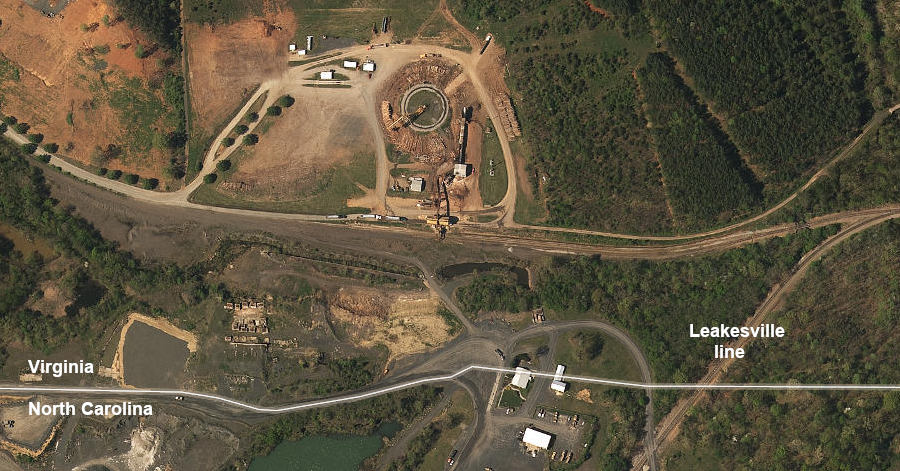
a facility producing wood chips now marks the end of the old Danville & Western Railway line in Virginia
Source: ESRI, ArcGIS Online
The roadbed around Martinsville is being converted into a recreation trail. The Dick and Willie Passage Rail Trail stretches 4.5 miles abandoned railroad right-of-way between trailheads on Virginia Avenue and Fisher Street.8
The conversion of the rail line to a pedestrian trail cost $1.4 million. Contributors included $800,000 from the Virginia Department of Transportation, $400,000 from the Federal government, and $111,000 from the Virginia Tobacco Indemnification and Community Revitalization Commission. In-kind donations from Henry County, Martinsville, and the Henry County Public Service Authority, plus some contributions from local businesses and individuals, provided the last $89,000.
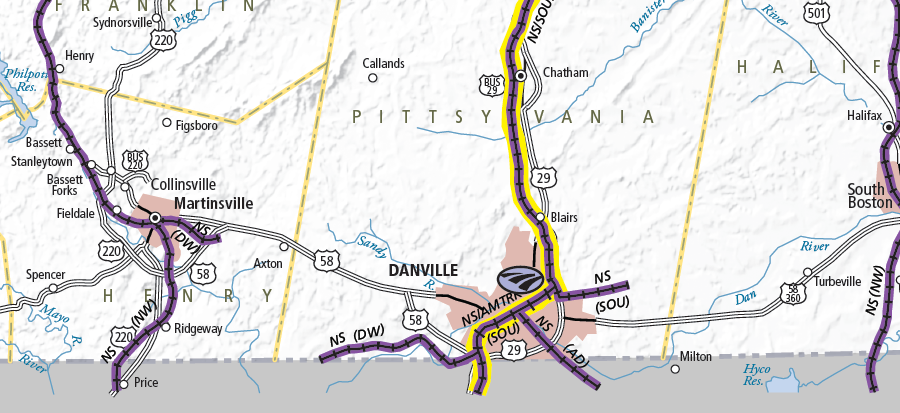
portions of the former Danville & Western Railway ("Dick and Willie") are still used, but are no longer connected between Danville and Martinsville
Source: Virginia Department of Rail and Public Transportation (DRPT), State Rail Map (2018)
Martinsville and Henry County officials hoped a trail network along the Smith River would attract tourists and stimulate the local economy. The success of the Virginia Creeper trail in Washington County in creating jobs and tax revenue was a model. A member of the Virginia Commonwealth Transportation Board commented at the trail's dedication on the state's $800,000 contribution, calling it:9
Plans call for constructing a 10-mile trail ultimately. The first extension, 2.5 miles on the eastern end, cost approximately $1.7 million. A $1.4 million grant from the Harvest Foundation covered most of the cost, with the Martinsville-Henry County Economic Development Corporation picking up the remainder.
The Danville & Western Railway, once a transportation component for an industrialized area, is being re-purposed. As described by an outdoor sports magazine, the rails-to-trails conversion was intended to help Martinsville shift from a manufacturing to a service economy:10
The old Danville, Mocksville & Southwestern Railroad route from Leakesville Junction to Eden is still operational.
Traffic had increased on that part of the Danville and Western, starting in 1949. Trains delivered coal to Duke Power's new Dan River Steam Station plant until 2012. The power plant shifted from coal to natural gas that year, but the change did not end all of the coal-related traffic.
A coal ash spill led to an agreement that Duke Power would excavate the coal ash and transport it to a location where it could not leak into the Dan River. Starting in 2015, half of that ash was shipped via the Danville and Western tracks back to Leakesville Junction and on to the Maplewood landfill in Amelia County.11
Pillowtex, which had acquired the Fieldcrest mills, closed the last one at Eden in 2003. Other companies have kept some textile operations active there, especially the manufacture of T-shirts that can be delivered to customers more quickly than products from lower-cost mills located in other countries. In 2015, MillerCoors announced the closure of its large brewery in Eden. That reduced freight traffic further on the rail line.12
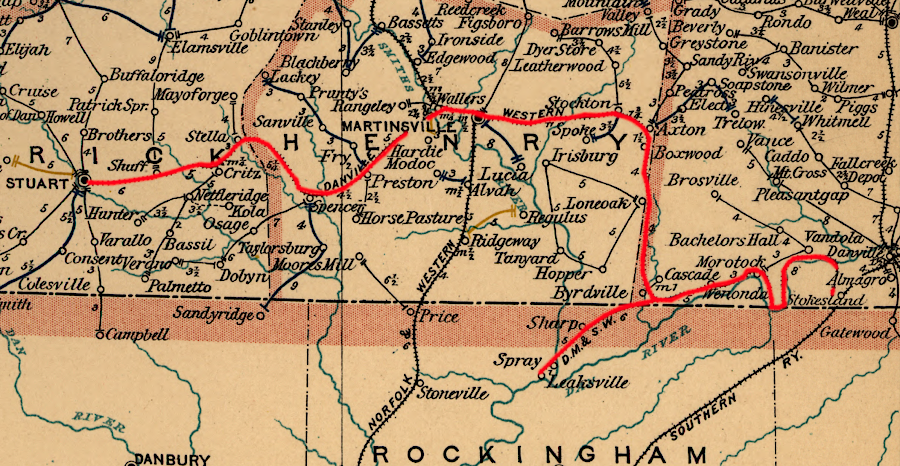
Danville and New River Railroad in 1896
Source: Library of Congress, Post route map of the state of Virginia and West Virginia (1896)
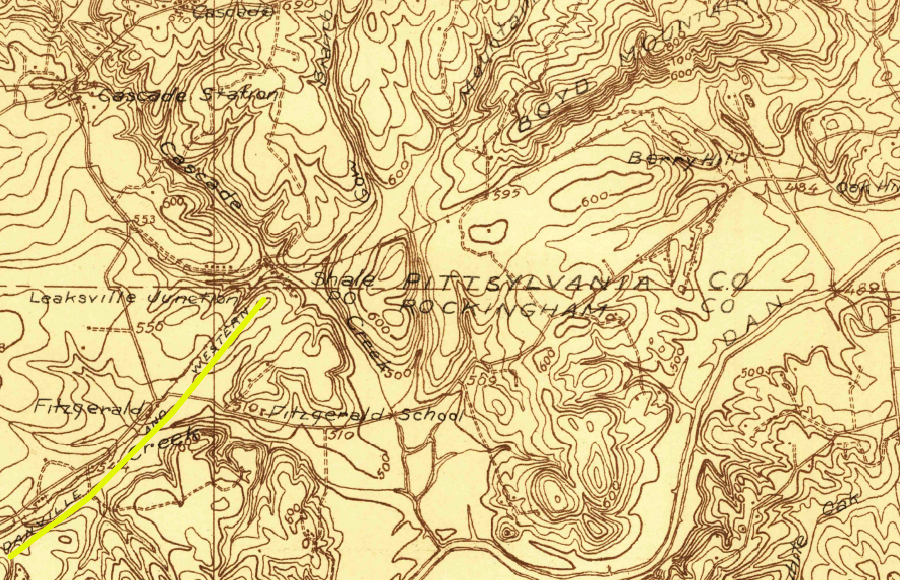
a branch from the former Danville & Western Railway ran south from Leakesville Junction near Cascade to Eden, North Carolina
Source: US Geological Survey (USGS), Draper 1:48,000 topographic quadrangle (1924)
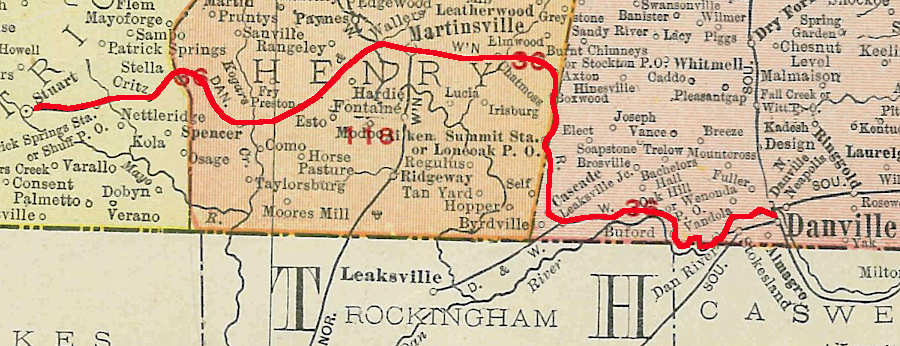
Danville & Western Railway in 1913
Source: National Archives, The Library Atlas of the World; Volume 1: United States (1913)